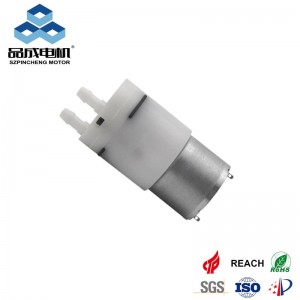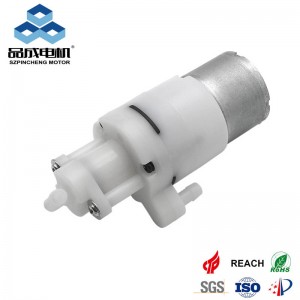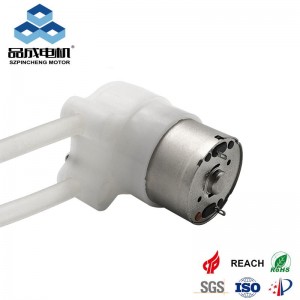DC micro diaphragm pumps, critical components in fluid control systems, are undergoing a transformative evolution driven by advancements in new materials. These innovations are reshaping industries ranging from biomedical engineering to environmental monitoring by enhancing performance, durability, and adaptability. This article explores how emerging materials are propelling the evolution of DC micro diaphragm pumps and their potential in diverse applications.
1. Shape Memory Alloys (SMAs) and Magnetostrictive Materials
Shape memory alloys (SMAs), such as nickel-titanium (NiTi), exhibit actuation capabilities under temperature or magnetic field changes, enabling precise fluid control. For instance, NiTi-based diaphragms integrated with MEMS technology achieve high-frequency operation (up to 50,000 Hz) with minimal energy consumption. These materials are ideal for implantable drug delivery systems and lab-on-a-chip devices, where small size and reliability are paramount. Similarly, giant magnetostrictive materials (GMM) enable rapid response in pumps for aerospace and robotics applications.
2. Nanomaterials for Enhanced Efficiency
Nanomaterials, including carbon nanotubes (CNTs) and graphene, are gaining traction due to their superior mechanical and thermal properties. CNT-reinforced polymers improve pump durability and reduce friction, extending lifespan in corrosive environments. Additionally, nano-composites enable lightweight yet robust pump components, critical for portable medical devices and electronics cooling systems. Recent studies highlight how nanomaterials enhance heat dissipation, making them suitable for high-power micropumps in automotive thermal management.
3. Flexible Polymers and Hydrogels
Flexible polymers like PTFE, PEEK, and electroactive hydrogels are pivotal in biomedical micropumps. Hydrogels, which swell or contract in response to electrical or chemical stimuli, offer low-energy actuation for long-term implantable systems. A valveless hydrogel micropump powered by a 1.5 V battery demonstrated continuous operation for 6 months with minimal energy consumption (≤750 μWs per stroke), making it viable for drug delivery. Similarly, biocompatible polymers like PDMS (polydimethylsiloxane) are widely used in microfluidic chips due to their transparency and chemical inertness.
4. Ceramic Materials for Extreme Environments
Ceramics, such as alumina (Al₂O₃) and zirconia (ZrO₂), are prized for their high hardness, corrosion resistance, and thermal stability. These materials excel in pumps handling abrasive slurries, high-temperature fluids (e.g., 550°C salt brine), or corrosive chemicals like sulfuric acid. Ceramic-coated piston rods and seals (e.g., Binks’ Exel pump) outperform traditional hard chrome components in wear resistance, reducing maintenance costs. In medical applications, ceramics ensure sterility and biocompatibility, making them ideal for precision filling in pharmaceuticals.
5. Biocompatible Materials for Medical Innovations
In healthcare, biocompatible materials like phospholipid-polymer composites and ceramics are essential for reducing hemolysis and thrombosis in blood pumps. For example, polyurethane-based membranes with surface modifications (e.g., phosphorylcholine groups) minimize protein adsorption, critical for implantable ventricular assist devices. Ceramics like sapphire (single-crystal alumina) offer low friction and chemical inertness, ensuring long-term reliability in drug delivery systems.
6. Smart Materials for Adaptive Systems
Smart materials (e.g., magnetic shape memory alloys and pH-responsive polymers) enable self-regulating micropumps. A recent study introduced a magnetic smart material-based micropump with one-way valves, achieving 39 μL/min flow rates and improved efficiency compared to conventional designs. These materials are particularly valuable in environmental monitoring and automated manufacturing, where real-time adjustments to fluid dynamics are necessary.
7. Market Trends and Future Directions
The global micropump market is projected to grow at a CAGR of 13.83% from 2025 to 2033, driven by demand in medical devices, environmental tech, and consumer electronics. Key trends include:
- Miniaturization: Integration of advanced materials into micromachines for portable diagnostics.
- Sustainability: Use of recyclable polymers and energy-efficient actuation (e.g., hydrogels) to reduce environmental impact.
- Intelligence: Development of AI-controlled smart pumps with real-time feedback mechanisms.
Challenges and Opportunities
While new materials offer unprecedented benefits, challenges like high manufacturing costs and complex processing persist. For example, ceramic components require precision machining, and SMAs demand intricate thermal control. However, advancements in 3D printing and nanomaterials are mitigating these issues. Future research may focus on self-healing materials and energy-harvesting designs to further optimize micropump performance.
Conclusion
New materials are pushing the boundaries of DC micro diaphragm pump technology, enabling applications once deemed impossible. From biodegradable hydrogels in drug delivery to high-temperature ceramics in industrial settings, these innovations are driving efficiency, reliability, and sustainability. As research progresses, micropumps will continue to play a pivotal role in advancing healthcare, environmental science, and smart manufacturing. By leveraging cutting-edge materials, engineers are unlocking a future where precision fluid control is both accessible and transformative.
you like also all
Read More News
Post time: May-13-2025




